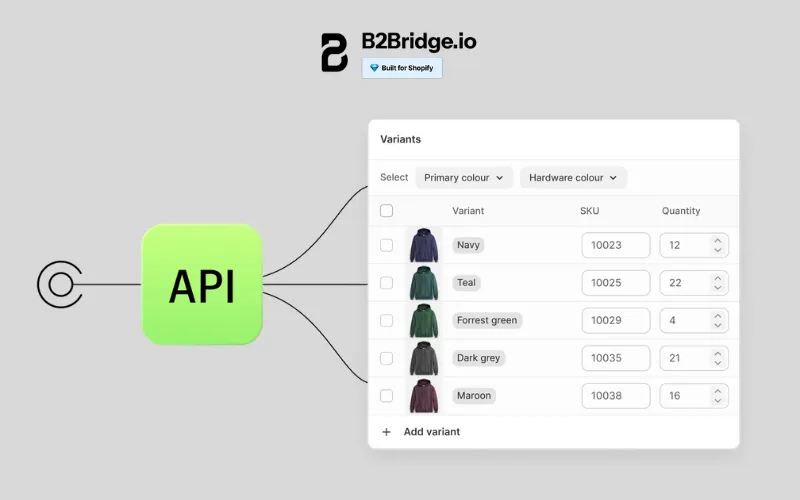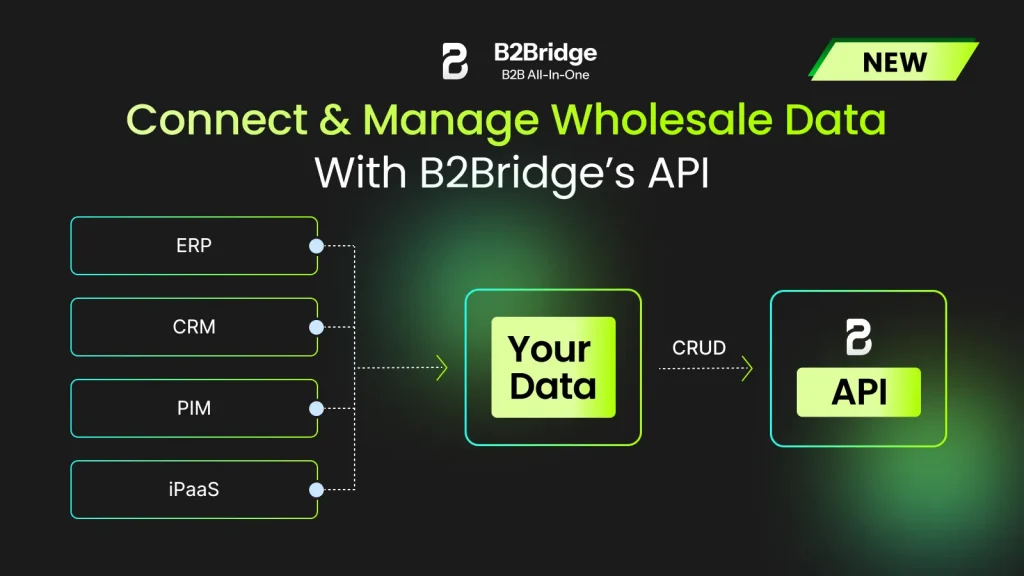Many B2B businesses still struggle with disconnected systems, manual data entry, and outdated processes that create operational bottlenecks and frustrate customers. This is where Shopify B2B integration becomes a game-changer.
This comprehensive guide provides actionable insights to help you plan, implement, and optimize your Shopify B2B integration strategy to maximize ROI. Whether you’re just starting your B2B journey or looking to upgrade existing integrations, you’ll find practical recommendations backed by real-world success stories.
What is Shopify B2B Integration?
Shopify B2B integration refers to the technical connection between Shopify’s Ecommerce platform and your backend business systems – including ERP (Enterprise Resource Planning), CRM (Customer Relationship Management), PIM (Product Information Management), and 3PL (Third-Party Logistics) platforms. These connections are established through APIs, middleware solutions, or native connectors that enable seamless data flow between systems.

By connecting Shopify’s powerful Ecommerce platform with your core business systems – ERP, CRM, inventory management, and financial software – you create a unified digital ecosystem that eliminates data silos, automates workflows, and delivers the sophisticated buying experience modern B2B customers demand.
Why do you need Shopify B2B Integration?
Real-Time Inventory and Pricing Synchronization: Eliminate stockouts and overselling by maintaining accurate product availability across all channels. Pricing updates in your ERP instantly reflect on your Shopify storefront, ensuring consistency and protecting margins.
Automated Order Processing: Orders flow automatically from Shopify to your fulfillment systems, reducing manual entry errors and accelerating order-to-cash cycles. Your team spends less time on data entry and more time on strategic activities.
Unified Customer Data: Customer information, order history, payment terms, and credit limits sync bidirectionally, giving sales teams complete visibility while enabling personalized buyer experiences on the storefront.
Enhanced Buyer Experience: B2B customers access real-time inventory, view custom pricing, check order status, and reorder quickly – all within a self-service portal that mirrors the convenience of modern B2C shopping.
Improved Operational Efficiency: Automation reduces manual touchpoints, minimizes errors, and accelerates processes across procurement, fulfillment, accounting, and customer service functions.
With B2B Ecommerce sales projected to reach $3 trillion in the U.S. alone by 2027, businesses that implement effective Shopify B2B integration position themselves to capture this massive growth opportunity while maintaining healthy margins.
Key Components of Effective Shopify B2B Integration
A successful Shopify B2B integration strategy addresses multiple functional areas. Here are the essential components that separate adequate integrations from exceptional ones.
Company Profiles and Multi-User Account Management
Unlike B2C transactions where individual consumers shop for themselves, B2B sales involve complex organizational structures. A single company may have multiple buyers with different roles, approval requirements, and purchasing permissions.
Effective integration enables:
- Hierarchical account structures that reflect real organizational relationships
- Role-based permissions controlling who can browse, add to cart, place orders, or approve purchases
- Multi-location support for companies with multiple shipping addresses or branch locations
- Approval workflows that route orders through appropriate stakeholders before submission
This complexity requires your Shopify B2B integration to synchronize company data structures from your CRM or ERP, ensuring that organizational hierarchies, user permissions, and approval processes remain consistent across systems.
Real-Time Inventory, Pricing, and Order Synchronization
Accuracy and speed define modern B2B commerce. Your integration must maintain real-time synchronization across critical data points:
Inventory Management: Stock levels update continuously across all sales channels. When a warehouse receives shipment or fulfills an order, Shopify reflects these changes instantly. This prevents the costly mistakes of overselling or disappointing customers with backorders.
Dynamic Pricing: B2B pricing is rarely one-size-fits-all. Your integration should support customer-specific pricing, volume discounts, contract pricing, and promotional terms – all synchronized from your ERP systems like Oracle NetSuite, Microsoft Dynamics 365, SAP Business One, or Sage.
Order Synchronization: When a customer places an order on Shopify, it should flow immediately into your ERP or order management system, triggering fulfillment workflows without manual intervention. Order status updates then flow back to Shopify, where customers can track their purchases in real-time.
Integration of Financial Systems and Payment Terms
B2B transactions involve significantly more financial complexity than retail sales. Your Shopify B2B integration must handle:
- Flexible payment terms including Net 30, Net 60, and Net 90 arrangements
- Credit management with automated credit limit checks before order approval
- Multi-currency support for international B2B sales with real-time exchange rates
- Tax calculation accounting for varying rates across jurisdictions, tax exemptions, and resale certificates
- Invoicing and credit memos synchronized between Shopify and your accounting systems
This financial integration ensures accurate accounting, reduces payment disputes, and maintains healthy cash flow – critical factors for B2B profitability.
Workflow Automation and Self-Service Portals
The most powerful Shopify B2B integrations go beyond data synchronization to enable intelligent workflow automation:
- Automated approval routing based on order value, product category, or customer status
- Reorder reminders triggered by purchase history and inventory thresholds
- Quote-to-order conversion enabling sales negotiations to flow seamlessly into transactions
- Shipment tracking providing delivery transparency through integrated logistics data
Self-service portals empower B2B buyers to check order status, download invoices, access product documentation, and manage their accounts independently – reducing support burden while improving customer satisfaction.
Popular Shopify B2B Integration Approaches
Businesses have multiple pathways to achieve effective Shopify B2B integration. The right approach depends on your existing technology stack, budget, timeline, and internal technical capabilities.
Native Shopify APIs and B2B Features
Shopify Plus offers built-in B2B functionality that provides a solid foundation for wholesale operations. The platform includes:
- Native B2B checkout experiences with custom payment terms
- Company and buyer account management
- Draft orders and quote functionality
- Wholesale pricing and customer-specific catalogs
Shopify’s extensive API ecosystem enables developers to extend these native features and create custom integrations with other business systems. For businesses with development resources, building directly on Shopify’s APIs offers maximum flexibility and control.
Middleware and iPaaS Solutions
Integration Platform as a Service (iPaaS) and middleware solutions provide pre-built connectors and visual workflow builders that simplify integration projects. Popular platforms include:
- Celigo: Specialized in NetSuite-Shopify integrations
- Jitterbit: Enterprise-grade integration platform supporting complex B2B scenarios
- Boomi: Dell’s cloud-native integration platform
- Workato: Low-code automation platform with extensive app connectors
These solutions accelerate implementation timelines and reduce dependency on custom development, making them ideal for businesses with legacy systems or limited technical resources. They handle the complex orchestration required to keep multiple systems synchronized reliably.
Custom API Development
For businesses with unique requirements or highly customized backend systems, custom API development offers maximum flexibility. Leveraging Shopify’s public API alongside specialized solutions like B2Bridge’s API enables:
- Tailored integration workflows matching exact business processes
- Complex business logic implementation
- Wholesale automation addressing specific industry requirements
- Integration with proprietary or niche business systems
Custom development requires greater upfront investment but delivers precise solutions that align perfectly with your operational model. B2Bridge streamlines this approach by providing wholesale-specific functionality that extends Shopify’s native B2B capabilities without building everything from scratch.
Why B2Bridge is the Ultimate App for Shopify B2B Integration
While Shopify provides strong native B2B capabilities, many businesses need additional functionality to deliver exceptional wholesale experiences. B2Bridge extends Shopify’s B2B platform with specialized features designed specifically for wholesale operations.

The Public API enables seamless, secure integration between B2Bridge and your existing systems like ERP, CRM, or custom backends, automating critical B2B workflows such as customer group management and pricing updates.
B2Bridge’s Public API empowers merchants to synchronize pricing and customer segmentation data in real time, drastically reducing manual labor, minimizing errors, and enhancing operational efficiency. This feature gives B2B businesses the flexibility to quickly adapt to market changes and scale confidently while delivering highly personalized buying experiences to verified customers.
For Shopify merchants aiming to run B2B as smoothly as B2C, streamline wholesale management, and future-proof their business, B2Bridge with its Public API is the definitive solution.
Take advantage of B2Bridge’s Public API to simplify wholesale operations, protect your pricing structures, automate order handling, and provide your buyers with a seamless self-serve shopping journey – all within a single integrated platform that grows with your wholesale business.
Best Practices to Maximize Shopify B2B Integration ROI
Implementing integration technology is just the beginning. Following these best practices ensures you extract maximum value from your investment.
Automating Operational Workflows
The greatest ROI from Shopify B2B integration comes from eliminating manual processes that consume staff time and introduce errors:
Registration and Onboarding: Automate wholesale customer application review, approval, and account creation. New customers move from registration to their first purchase without manual intervention.
Pricing Updates: Eliminate manual price list uploads. Price changes in your ERP sync automatically to Shopify, ensuring accuracy and saving countless administrative hours.
Order Processing: Remove manual order entry entirely. Orders flow from Shopify directly into fulfillment systems, reducing processing time from hours to minutes while eliminating transcription errors.
Inventory Management: Stop manually adjusting stock levels across systems. Real-time synchronization ensures accuracy while freeing staff for value-added activities.
Payment Follow-Up: Automate payment reminders for Net terms customers, reducing days sales outstanding (DSO) and improving cash flow without additional collection staff.
Each automated workflow generates measurable savings. A mid-sized B2B operation processing 500 orders monthly can easily save 20-30 hours of administrative time weekly through comprehensive automation – equivalent to nearly one full-time employee.
Enhancing the B2B Buyer Experience
Modern B2B buyers have been trained by consumer Ecommerce experiences. They expect the same convenience, speed, and transparency in their business purchases. Integration enables these elevated experiences:
Personalized Catalogs: Display only relevant products based on customer purchasing authority, preferences, or contract terms. Buyers find what they need faster without sorting through irrelevant inventory.
Real-Time Product Availability: Show accurate stock levels and expected delivery dates so buyers can make informed purchasing decisions and plan accordingly.
Self-Service Account Management: Enable customers to view order history, track shipments, download invoices, and manage their account information independently – reducing support tickets while increasing satisfaction.
Quick Reordering: Integrate purchase history so buyers can reorder previous items with one click, dramatically reducing friction for repeat purchases.
Transparent Pricing: Display customer-specific pricing, volume discounts, and contract terms clearly, building trust and encouraging larger orders.
Businesses that deliver superior B2B buyer experiences see measurable results: higher customer retention rates, increased average order values, and reduced customer acquisition costs as satisfied buyers provide referrals.
Key Metrics to Monitor Integration Performance
What gets measured gets managed. Track these metrics to quantify your Shopify B2B integration ROI:
Order-to-Cash Cycle Time: Measure the duration from order placement to payment receipt. Effective integration should dramatically reduce this timeline, improving cash flow and operational efficiency.
Synchronization Speed and Accuracy: Monitor how quickly data updates propagate across systems and track sync error rates. Near-instant, error-free synchronization indicates healthy integration.
Inventory Accuracy: Compare physical inventory counts against system data across all platforms. Integration should maintain 98%+ accuracy, preventing costly stockouts and oversells.
Customer Satisfaction Scores: Survey B2B customers about their ordering experience. Integration improvements should correlate with rising satisfaction ratings.
Operational Cost Savings: Calculate staff hours saved through automation and reduction in error correction. These savings directly impact your bottom line.
Sales Velocity: Track how integration affects sales cycle length and conversion rates. Faster, smoother buying experiences should accelerate revenue growth.
Establishing baseline metrics before integration and tracking improvements over time provides concrete evidence of ROI for stakeholders.
Case Studies Highlighting Shopify B2B Integration Success
Real-world examples illustrate how businesses achieve tangible results through effective Shopify B2B integration.
Allied Medical: Precision Through ERP Integration
Allied Medical, a healthcare equipment distributor, struggled with order accuracy issues and limited visibility into inventory across multiple warehouses. Manual order processing created delays and errors that frustrated both customers and internal teams.
After implementing comprehensive Shopify ERP integration, Allied Medical achieved:
- 40% reduction in order processing time through automated workflows
- Near-elimination of data entry errors that previously caused shipping mistakes
- Real-time inventory visibility across all warehouse locations
- Enhanced customer transparency with self-service order tracking
The integration paid for itself within six months through operational savings and improved customer retention.
DARCHE: Scaling Growth Through Integration
DARCHE, an outdoor equipment manufacturer, experienced rapid growth that strained their manual order management processes. Inventory discrepancies between their ERP and Shopify storefront caused customer service issues and lost sales.
Their Shopify B2B integration delivered:
- 3x growth in B2B sales over 18 months without proportional staff increases
- Real-time inventory synchronization eliminating overselling and backorder surprises
- Automated pricing updates maintaining margin protection during market volatility
- Streamlined wholesale onboarding reducing new customer setup from days to hours
DARCHE’s leadership credits integration with enabling their aggressive growth trajectory while maintaining service quality.
Key Lessons from These Success Stories
These case studies reveal common success patterns:
- Quick ROI: Most integrations pay for themselves within 6-12 months through operational savings
- Scalability without proportional cost increases: Integration enables revenue growth without linear staff expansion
- Improved customer satisfaction: Buyers appreciate accuracy, speed, and transparency
- Competitive advantage: Businesses with superior B2B experiences capture market share from competitors still using manual processes
FAQs About Shopify B2B Integration
How does Shopify support multi-account B2B customers?
Shopify Plus offers native company and buyer account management that supports hierarchical organizational structures. Multiple users from the same company can have different roles and permissions. Through integration with your CRM or ERP, you can sync complex account structures, approval workflows, and permission hierarchies that reflect real-world B2B relationships.
What payment and pricing flexibility is possible via Shopify integrations?
Shopify B2B integration supports extensive payment and pricing flexibility including Net 30/60/90 payment terms, customer-specific pricing, volume discounts, contract pricing, multi-currency transactions, tax exemptions, and credit limit management. Integration with your ERP or accounting system ensures these terms remain synchronized and accurately enforced.
Can Shopify integrate with multiple ERP systems?
Yes, Shopify can integrate with virtually any ERP system including Oracle NetSuite, Microsoft Dynamics 365, SAP Business One, Sage, Acumatica, and others. Integration is achieved through native APIs, middleware platforms, or custom development depending on your specific systems and requirements.
What security practices protect B2B data during integration?
Professional Shopify B2B integrations employ multiple security layers including encrypted data transmission (TLS/SSL), secure API authentication, role-based access controls, regular security audits, compliance with PCI DSS standards for payment data, and data residency controls for international operations. Always verify that integration partners follow security best practices and maintain relevant certifications.
What is the typical timeline and cost of Shopify B2B integrations?
Implementation timelines vary significantly based on complexity. Simple integrations using middleware platforms might complete in 4-8 weeks, while complex custom integrations with multiple systems could require 3-6 months. Costs range from $10,000-$50,000 for mid-market implementations to $100,000+ for enterprise-scale projects with extensive customization. You can use a Shopify app like B2Bridge to accelerate integration – automating registration, pricing, order management, and more just from $199/month.
Emerging Trends in Shopify B2B Integration for 2026 and Beyond
The Shopify B2B integration landscape continues evolving rapidly. Stay ahead of these emerging trends:
Increased Demand for Near Real-Time Data Synchronization
The days of overnight batch processing are ending. B2B buyers expect instant inventory updates, immediate order confirmation, and real-time shipment tracking. Integration architectures are shifting toward event-driven, near-instantaneous data synchronization that maintains accuracy across systems with minimal latency.
Growing Adoption of API-First Integration Architectures
Businesses are moving away from monolithic integration approaches toward composable, API-first architectures that offer greater flexibility and easier maintenance. This trend enables businesses to swap systems, add new capabilities, and scale operations without major integration rewrites.
Rising Importance of Seamless Omnichannel Buyer Experiences
B2B buyers increasingly interact with brands across multiple touchpoints – online storefront, mobile apps, sales representatives, marketplaces, and physical locations. Integration must unify these channels, ensuring consistent pricing, inventory visibility, and customer data regardless of how buyers choose to engage.
Expansion of Global Compliance and Tax Considerations
As B2B Ecommerce expands internationally, integration must handle complex global tax scenarios, regulatory compliance requirements, and cross-border transaction rules. Expect integration platforms to offer more sophisticated compliance automation in response to evolving international commerce regulations.
Businesses that anticipate and adapt to these trends will maintain competitive advantages as the B2B digital landscape continues maturing.
Conclusion
Shopify B2B integration has evolved from a nice-to-have enhancement to an essential capability for competitive wholesale operations. As we move through 2026, businesses that connect Shopify seamlessly will capture market share from competitors still relying on manual processes and disconnected systems.
And most importantly, select solutions like B2Bridge that understand wholesale-specific requirements and provide capabilities designed explicitly for B2B operations.
Ready to transform your Shopify B2B operations through powerful integration? B2Bridge provides the wholesale-specific features and seamless connectivity you need to maximize ROI while delivering exceptional buyer experiences. Explore how B2Bridge can streamline your wholesale operations and accelerate B2B growth today.
Hi, I’m Ha My Phan – an ever-curious digital marketer crafting growth strategies for Shopify apps since 2018. I blend language, logic, and user insight to make things convert. Strategy is my second nature. Learning is my habit. And building things that actually work for people? That’s my favorite kind of win.






